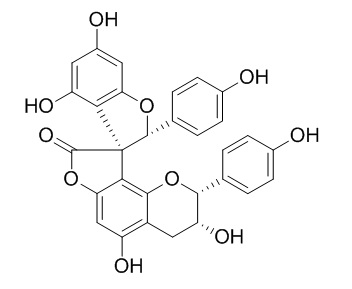Larixinol
Larixinol shows antioxidant activity, it also shows moderate inhibitory activities against LPS-induced NO production in macrophages with an IC(50) value of 60.0 microg/mL.
Inquire / Order:
manager@chemfaces.com
Technical Inquiries:
service@chemfaces.com
Tel:
+86-27-84237783
Fax:
+86-27-84254680
Address:
1 Building, No. 83, CheCheng Rd., Wuhan Economic and Technological Development Zone, Wuhan, Hubei 430056, PRC
Providing storage is as stated on the product vial and the vial is kept tightly sealed, the product can be stored for up to
24 months(2-8C).
Wherever possible, you should prepare and use solutions on the same day. However, if you need to make up stock solutions in advance, we recommend that you store the solution as aliquots in tightly sealed vials at -20C. Generally, these will be useable for up to two weeks. Before use, and prior to opening the vial we recommend that you allow your product to equilibrate to room temperature for at least 1 hour.
Need more advice on solubility, usage and handling? Please email to: service@chemfaces.com
The packaging of the product may have turned upside down during transportation, resulting in the natural compounds adhering to the neck or cap of the vial. take the vial out of its packaging and gently shake to let the compounds fall to the bottom of the vial. for liquid products, centrifuge at 200-500 RPM to gather the liquid at the bottom of the vial. try to avoid loss or contamination during handling.
Korean Journal of Pharmacognosy.2020, 51(2):100-106
Ann Transl Med.2019, 7(23):731
Biomed Pharmacother.2024, 175:116770.
Heliyon.2024, 10(7):e28364.
Viruses2023, 15(6), 1377
RSC Adv.2023, 13(9):6317-6326.
Bioinformatics 2024, 586957
Front Pharmacol.2019, 10:1025
Drug Des Devel Ther.2020, 14:5189-5204.
Clin Transl Oncol.2019, 10.1007
Related and Featured Products
J Nat Prod. 2004 May;67(5):882-5.
Yucca schidigera bark: phenolic constituents and antioxidant activity.[Pubmed:
15165156 ]
Two new phenolic constituents with unusual spirostructures, named yuccaols D (1) and E (2), were isolated from the MeOH extract of Yucca schidigera bark.
METHODS AND RESULTS:
Their structures were established by spectroscopic (ESIMS and NMR) analysis. The new yuccaols D and E, along with resveratrol (3), trans-3,3',5,5'-tetrahydroxy-4'-methoxystilbene (4), yuccaols A-C (5-7), yuccaone A (8), Larixinol (9), the MeOH extract of Yucca schidigera bark, and the phenolic portion of this extract, were assayed for antioxidant activity by measuring the free radical scavenging effects using two different assays, namely, the Trolox Equivalent Antioxidant Capacity (TEAC) assay and the coupled oxidation of beta-carotene and linoleic acid (autoxidation assay).
CONCLUSIONS:
The significant activities exhibited by the phenolic fraction and its constituents in both tests show the potential use of Y. schidigera as a source of antioxidant principles.
Planta Med. 2009 Nov;75(14):1534-7.
Two new spirobiflavonoids from Abies chensiensis with moderate NO production inhibitory activity.[Pubmed:
19499503 ]
Phytochemical investigation of the aerial parts of Abies chensiensis afforded two new (compounds 2 and 3) and 27 known compounds, including the related compound Larixinol ( 1).
METHODS AND RESULTS:
The structures of spirobiflavonoids 1- 3 were established using 1D and 2D NMR spectroscopic techniques. In addition, the structure of Larixinol ( 1) was confirmed by X-ray crystallographic analysis. Compounds 1- 3 were evaluated for inhibitory activities against LPS-induced NO production in macrophages.
CONCLUSIONS:
Larixinol ( 1) showed moderate effects, with an IC(50) value of 60.0 microg/mL. In addition, it did not show any cytotoxicity on RAW 264.7 macrophages at 100 microg/mL.



